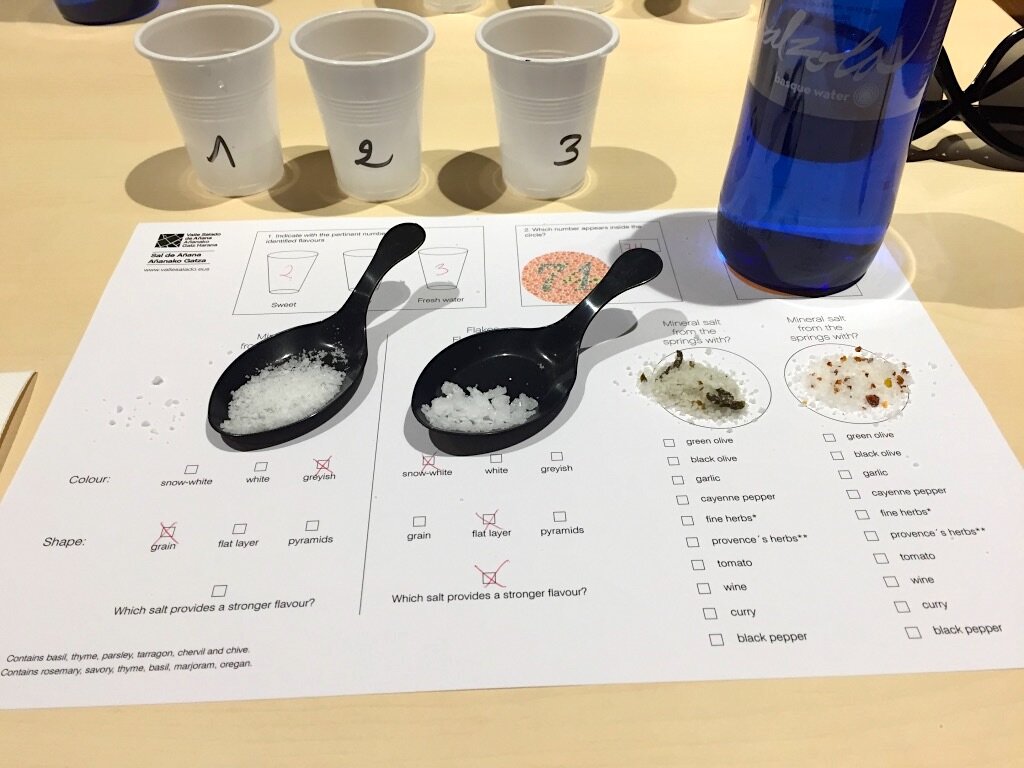Eating Rocks in Basque Country
In the depths of a dreary Chicago winter, as I was salting the outdoor stairs, I suddenly recollected my visit to the 7,000 year old Valle Salado de Añana in Basque Country, Spain. This trip was part of a school excursion where we visit a region of the world in order to meet local producers, understand their business, and taste their products. Spain holds a special place in my heart, as it feels like home when I’m there. The Basque region overflows the travelers cup by offering culinary delights, nature extraordinaire, and a unique historical culture that yields rich experiences at every turn.
We were visiting the inland saline valley that is classified as an UNESCO “world agricultural heritage” site. Without getting into the nitty gritty about the science-y details, the fact that salt exists in this area of the world is because of a geological phenomenon called diapiro. It’s a process that began about 220 million years ago and basically involves pressure and materials that are less dense to be pushed upwards. The important fact to highlight about Añana salt is that it is naturally derived from the evaporation of water.
The landscape of the valley is a mixture of manmade structures and nature coexisting in a stark way. There is stone, wood, clay, and water in a tiered fashion with rolling hills in the surrounding area. The word “flow” came to mind as I stood there. The salt springs are the starting point for the salt process, and from here the water is transported through “royos” (network of stone channels) into the wells. The salt water is poured and stored into flat beds called “eras”. After the salt crystallizes atop an era, it is collected and stored underneath in a warehouse, until the final step of packaging.
It was so cool to see world renowned local chef ambassadors’ support with their salt eras displayed such as Joan Roca of Cellar de Can Roca and Andoni Aduriz of Mugaritz. I’m just saying, if it’s good enough for these chefs, I think it will be good enough for me!
Throughout history, salt has held a prominent place and was even used as currency in ancient Rome thereby forming the word “salary”. Salt is an essential nutrient for human life, as in, we cannot survive without it. I would argue the same goes for cooking. The ingredient’s ability to elevate taste and take foods from ordinary to sublime is unparalleled. It is the only rock we eat. It is one of the 5 basic taste sensations. I love salt. From the culinary varietals to salt lamps to salt baths, I am a devout fan.
Before this moment, when I thought about salt, the image of the young girl with the yellow raincoat carrying the cylindrical can of salt which (gasp) was pouring out (aye yay aye food waste) flashed in my mind. Being from Chicago, I thought of the Morton Salt Company and the warehouse that I passed on Elston Avenue hundreds of times. Being here in the midst of millions of years of history I thought about how these salts could not be more disparate. The air was as pure, crisp, and fresh as I had ever experienced. I was in awe of Mother Nature: how she sustains purity, how beautiful she is, and how privileged we are. A trip to savor forever!
Photo Credits: Annie McKay + Felix Venner + Shilpa’s
Ask
If you are interested in learning more, visit in person or visit: https://vallesalado.com/VALLE-SALADO-HOME. Check out the various salt offerings, from flor de sal to finish a dish, salt stalactites (!) to grind on finished dishes, and liquid salt to dress salads or meats before cooking. This is a non-profit organization and the money goes back into preserving the salt area.
I haven’t read it but if interested in nerding out about salt, I heard “Salt: A World History” is good.
I enjoyed Samin Nosrat’s coverage of salt from Japan in her cookbook Salt Fat Acid Heat and Netflix show.
I hope to visit Atacama Salt Flat in Chile or Salar de Uyuni in Bolivia some day. Have you been? Share your salt story below!











